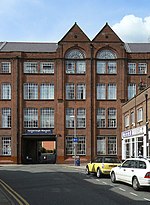Market Harborough is a market town in the Harborough district of Leicestershire, England, close to the border with Northamptonshire. The town's population was 25,143 in 2020. It is the administrative headquarters of the Harborough district.Market Harborough was formerly part of Rockingham Forest, a royal hunting forest used by the medieval monarchs starting with William I, whose original boundaries stretched from Market Harborough through to Stamford and included Corby, Kettering, Desborough, Rothwell, Thrapston and Oundle. The town was formerly at a crossroads for both road and rail; however, the A6 now bypasses the settlement to the east and the A14 which carries east-west traffic is 6 miles (9.7 km) to the south. Market Harborough railway station is served by East Midlands Railway services on the Midland Main Line with direct services north to Leicester, Nottingham, Derby and Sheffield, and south to London St Pancras. Rail services to Rugby and Peterborough ended in 1966.
The steeple of St Dionysius' Church rises directly from the street, as there is no churchyard. It was constructed in grey stone in 1300 with the church itself a later building of about 1470. Next to the church stands the Old Grammar School, a small timber building dating from 1614. The ground floor is open, creating a covered market area and there is a single room on the first floor. It has become a symbol of the town. The nearby square is largely pedestrianised and surrounded by buildings of varying styles. The upper end of the High Street is wide and contains mostly unspoiled Georgian buildings.
Market Harborough has two villages within its confines: Great Bowden lies over a hill about a mile from the town centre, and Little Bowden is less than half a mile from the town centre. The three centres have largely coalesced through ribbon development and infill, although Great Bowden continues to retain a strong village identity.








